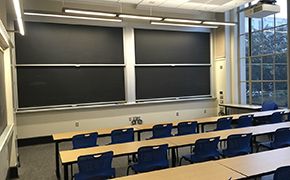Instructor Insights pages are part of the OCW Educator initiative, which seeks to enhance the value of OCW for educators.
Instructor Insights
Professor Yufei Zhao, who took 18.A34 Mathematical Problem Solving (Putnam Seminar) as an undergraduate at MIT and was a three-time Putnam Fellow, has gone on to a flourishing career in mathematics:
It is an incredibly satisfying feeling to struggle with an interesting problem and eventually solve it.
— Yufei Zhao
Yufei Zhao Wins Future of Science Award
Four from MIT Named 2019 Sloan Research Fellows
Under his coaching, MIT students have been remarkably successful in the Putnam Competition:
MIT Students Take Back Putnam Competition Honors
Below, Professor Zhao describes various aspects of how he teaches the Putnam Seminar.
OCW: How do you cultivate and sustain students’ interest in problem-solving?
Yufei Zhao: By exposing them to interesting problems that hook them. It is an incredibly satisfying feeling to struggle with an interesting problem and eventually solve it.
OCW: What strategies do you use to promote students’ perseverance during problem-solving?
Yufei Zhao: I try to show them how the problems we discuss are related to more advanced mathematics and help them see the big picture. (Of course, in research, the time horizon is much longer than in math competitions!)
OCW: In what ways does the Putnam Seminar create a sense of community among learners engaged in problem-solving?
Yufei Zhao: Each week one of the classes is a lecture (often guest lectures by upper-level undergraduates who have previously done well in the Putnam Competition) and the other class is for student presentations of homework problems. The student presentations really help in building the sense of community. During student presentations, the other students in the class often comment and point out flaws or gaps in the arguments presented. I also try to encourage good presentation skills.
Curriculum Information
Prerequisites
None
Requirements Satisfied
Unrestricted elective credits ![]()
Offered
Every fall semester
Assessment
Grade Breakdown
- Grading was based on homework and in-class presentations.
- All students registered in the class were required to participate in the Putnam Competition.
Student Information

Enrollment
In the Fall 2018 semester, enrollment was 18 students, an increase from 7–12 students in previous years
Breakdown by Year
First-year students
Breakdown by Major
Mostly prospective math majors, some prospective computer science majors
Typical Student Background
Most students have previous experience with math competitions and camps from high school
During an average week, students were expected to spend 6 hours on the course, roughly divided as follows:
In Class
- Met 2 times per week for 1 hour per session; 26 sessions total; mandatory attendance
- First session each week: usually a lecture, delivered by an upper-level undergraduate
- Second session each week: student presentations of solutions to homework problems
- Last five class sessions: student presentations of solutions to past Putnam Competition problems and to student-created Putnam-type problems
Out of Class
- Completion of at least 6 problems each week, drawing on the week’s topic-based problem sets and sets of supplementary problems
- Preparation for in-class presentations
- Preparation for Putnam Competition
Semester Breakdown
| WEEK | M | T | W | Th | F |
|---|---|---|---|---|---|
| 1 |  |  |  |  |  |
| 2 |  |  |  |  |  |
| 3 |  |  |  |  |  |
| 4 |  |  |  |  |  |
| 5 |  |  |  |  |  |
| 6 |  |  |  |  |  |
| 7 |  |  |  |  |  |
| 8 |  |  |  |  |  |
| 9 |  |  |  |  |  |
| 10 |  |  |  |  |  |
| 11 |  |  |  |  |  |
| 12 |  |  |  |  |  |
| 13 |  |  |  |  |  |
| 14 |  |  |  |  |  |
| 15 |  |  |  |  |  |
| 16 |  |  |  |  |  |
 No classes throughout MIT
No classes throughout MIT Lecture session
Lecture session Problem set due
Problem set due No class session scheduled
No class session scheduled Student presentations
Student presentations

 Room 1 of 1
Room 1 of 1 